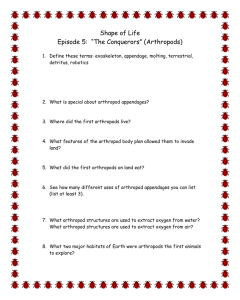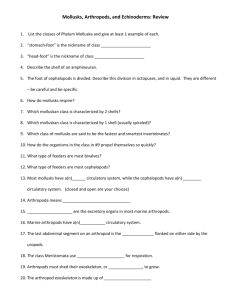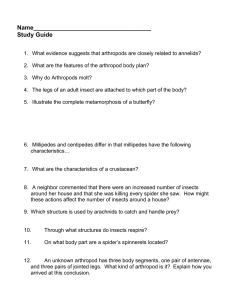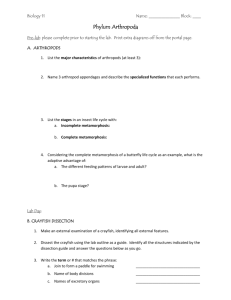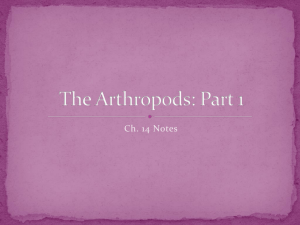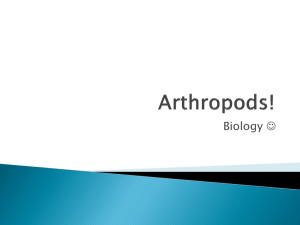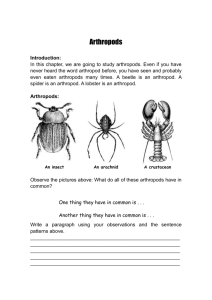Arthropods! - Tanque Verde Unified School District
advertisement
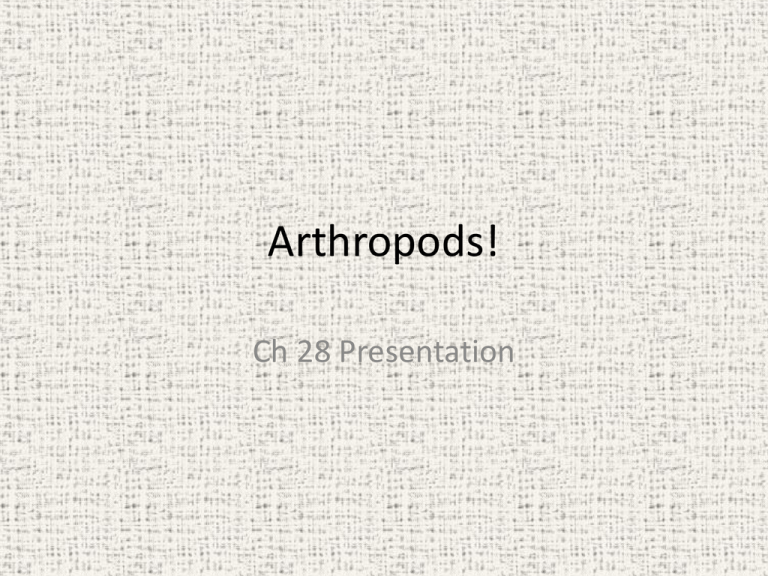
Arthropods! Ch 28 Presentation Common Characteristics of all Arthropods • Typical arthropod: – – – – Segmented Coelomate with Bilateral symmetry Invertebrate with exoskeleton Jointed structures called appendages • Appendage—any structure (e.g. leg, antenna) that grows out of the body of an animal • In arthropods, appendages are adapted for walking, sensing, feeding, mating, etc. • Arthropods are earliest known invertebrates to exhibit jointed appendages – Joints allow for flexibility of rigid exoskeleton (think knight in suit of armor) – Joints enable many uses for various appendages (e.g. mating in spiders, stinging in scorpions) Exoskeletons Support and Protect • Exoskeleton—hard, thick outer covering of protein and chitin • In some species, exoskeleton is continuous over entire body, in others it is separate plates held together by hinges • Exoskeleton supports internal tissues, provides places for muscle attachment • In many terrestrial species, exoskeleton covered with waxy layer to minimize water loss • In many aquatic species, exoskeleton reinforced with calcium carbonate Oh no, it’s MOLTING! • Why molt? – Exoskeletons are heavy and thick (the larger the muscles, the heavier/thicker must the exoskeleton be), so weight is limited for arthropods • Terrestrial and flying arthropods have thinner, lighter (but more fragile) exoskeletons but are less protected • Molting—shedding the old exoskeleton (new soft skeleton formed underneath first) • Animal takes in air/water and contracts muscles, which swell and split old skeleton • Most arthropods molt 4-7x during lifetime before becoming adults • Mid-molt, animals are vulnerable to predators, so many hide or remain motionless until their new skeleton hardens • http://youtu.be/2A1i10ZIB-w http://youtu.be/ffo37DlH5DM http://youtu.be/4QIgW639Oog Segmentation • Most arthropods are segmented but do not have as many segments as worms • In most groups, segments fused into three zones: – Head, thorax, abdomen • Sometimes head and thorax fused together into cephalothorax Breathing • Arthropods have efficient gas exchange—generally quick, active animals with high oxygen requirements • Three types of respiratory structures: – Gills – Tracheal tubes – Book lungs • In some arthropods, gas exchange occurs across exoskeleton (so it must be thin and permeable) • Aquatic arthropods use gills • Land arthropods use either tracheal tubes or book lungs • Most insects use tracheal tubes (branching networks of hollow air passages that carry air throughout body) • Air enters and leaves body through openings on thorax and abdomen called spiracles • Spiders and their relatives use book lungs, air-filled chambers with leaf-like plates (maximize surface area for gas exchange) • Tracheal Tubes and Spiracles • • Book Lungs Book Lungs Acute Sensory Perception • Why can arthropods respond so quickly to their environment? – Strong muscular contraction – Detect movement, chemicals and sound with antennae • Antennae have odor and sound receptors that are used in communication with other members of species (spiders lack these) • Pheromones—chemical odor signals given off by animals (signal animals to engage in variety of behaviors) – Accurate vision: EYES • Most arthropods have one pair of large compound eyes and 3-8 simple eyes • Simple eyes- single lensed-structures for detecting light • Compound eyes—visual structures with many lenses – Each lens registers a tiny portion of the field of view, so the total image is made of thousands of parts (panoramic view) Eyes What structures allow this damselfly to sense its environment? Well-developed Nervous Systems • Arthropods process information from sense organs with well-developed nervous systems • Consists of double ventral nerve cord (pearl necklace), an anterior brain, and several ganglia http://youtu.be/0uTdTRXNdEY Arthropod Circulation • Open circulatory system—blood is pumped by a heart, through vessels that bathe the tissues of the body, returns to heart through open spaces Complex Digestive Systems • Mouth, stomach, intestine, anus, glands that produce digestive enzymes Diversity of Mouthparts • Mouthparts are grouped and adapted for a vast variety of foods eaten by arthropods – Mandibles for chewing, pinching, holding – Pairs of appendages for moving food around while chewing http://youtu.be/yBHqJrKtlso http://youtu.be/ZJyeFSq3STM • Some insects have blade- or needle-like mouthparts for piercing for drawing blood, etc., while others have sponging tongues to lap up food, rolled-up proboscises for sucking up food Insect Mouthparts • Most mouthparts of arthropods include one pair of mandibles (green) http://youtu.be/QOIJPG25gr0 – These are adapted for holding, chewing, or biting various foods • Labrum: upper-most mouthpart (red) – fused plate to hold food in place during chewing • Maxillae (yellow): hold and manipulate food during mastication – Hairs and “teeth” along inner ridge – Palps used for sensing the characteristics of potential foods – Modified into proboscis or strawlike tube for sucking up food http://youtu.be/MYWPWTme_YI • Labium: “floor” of the mouth, assists during chewing (blue) • Hypopharynx: base of labium, assists in swallowing Crustacean Mouthparts • Three pairs of appendages modified into mouthparts that manipulate and bring food into mouth (mandibles followed by two pairs of maxillae) http://youtu.be/25F7xMVNt-w – Paired appendages offer opposable surfaces for grinding and biting food – Often followed by setae used to collect food Arachnid Mouthparts • Spiders and scorpions have chelicerae—pointed appendages used to grasp food – In spiders, they are hollow and contain venom glands Other well-developed systems • Excretory: Malpighian tubules that remove waste from abdomen; attached to and empty into the intestine • Muscular: muscle is attached to inner surface of exoskeleton on both sides of joints Sexual Reproduction • Most arthropods have separate males and females and reproduce sexually – Fertilization usually internal, sometimes external in aquatic species • A few species hermaphroditic – Barnacles • Parthenogenesis—asexual reproduction in which new individual develops from unfertilized egg (ex. Bees, wasps, ants, aphids; males with only one X chromosome) • Reproductive diversity one reason why more arthropod species than ALL the other animal species combined Arthropod Diversity • Arachnidae: Spiders, scorpions, mites, and ticks • Spiders have two body sections: cephalothorax, abdomen • Six pairs of jointed appendages • Chelicerae: first pair of appendages located near the mouth • Modified into pincers or fangs, spiders have no mandibles for chewing • Pedipalps: second pair, adapted for handling food and sensing food • Arachnids have no antennae • Spiders can make elaborate webs– though all spiders spin silk, not all make webs • Silk secreted in glands in abdomen, then spun together into thread by spinnerets located at rear of spider • Ticks, mites, scorpions: only one body section (head, thorax, and abdomen completely fused • Mites feed on fungi, plants, animals • Small but can expand body size up to 3x original size • Scorpions have long tail with venomous stinger at tip, enlarged pincers Arthropod Diversity • Crustacea: body sections, two pairs of antennae for sensing, two compound eyes, mandibles for crushing food (ex. Shrimp, lobsters, crabs, barnacles, crawdads – Crustacean mandibles open and close side to side – Many have five pairs of walking legs • Used for walking, seizing prey, cleaning appendages • First pair of walking legs often modified into strong claws for defense Arthropod Diversity • Chilopoda: centipedes, Diplopoda: millipedes – Have Malpighian tubules for excreting wastes – Tracheal tubules for gas exchange – Centipedes are carnivorous with painful bites • May have 15-181 body segments, each with one pair of legs – Millipedes don’t bite, eat mostly plants and dead material on forest floors • Spray foul-smelling fluid from stink glands as defense • May have 20 to 100+ segments, with two spiracles and legs each Arthropod Diversity • Merostomata: Horseshoe crabs— ”living fossils” – Three living genera, one (Limulus) lives along North American East Coast, two live in Asian tropics – Limulus fossils unchanged since Triassic Period 220 mya – Heavily protected by extensive exoskeleton; live in deep coastal waters; forage for algae, annelids, mollusks – Migrate to shallow water in spring, mate at night during high tide Arthropod Diversity • Insecta: the most successful class of arthropods • 3 body segments, six legs, more species of insects than all other animals combined • Reproduction: usually once during lifetime, internal fertilization – Parthenogenesis: in aphids all female offspring; in bees/ants/wasps all male – Most lay large # of eggs, increases chances of offspring survival to reproductive maturity Metamorphosis • Metamorphosis—change in body shape from egg to adult, controlled by series of chemical changes in animal – EggLarvaPupaAdult – If insect goes through all four stages: complete – If insect goes through some stages: incomplete (nymph stage) – Complete metamorphosis advantageous for arthropods because larvae don’t compete with adults for the same food Origins of Arthropods • Successfully covered the whole surface of Earth more than any other group of animals because of their ability to survive in almost every habitat – Exoskeletons, life cycles, high reproductive output, small size, jointed appendages • Most likely evolved from annelid ancestor – Evolved fused body segments that adapted for movement, sensing environment – More complex than annelids (eyes, nervous tissue) – Trilobites were major group of ancient arthropods, but have been extinct 248 million years

